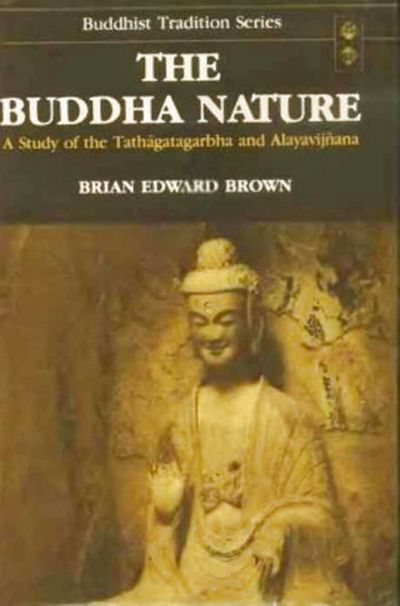- Foreword by Alex Waymanv
- Introduction
- Part Onexv
- Part Twoxxviii
- Part Threexxxvi
- Part One
- The Tathāgatagarbha in the Śrī-Mālā Sūtra and the Ratnagotravibhāga
- Chapter
- I. Analysis of the Śrī-Mālā Sūtra3-41
- Tathāgatagarbha as Ontic Subjectivity4
- Tathāgatagarbha and Soteriology8
- The Status of the Buddha15
- Tathāgatagarbha and Epistemology17
- The Nescience Entrenchment20
- The Buddha Natures22
- The Four Noble Truths25
- Tathāgatagarbha as Both Śūnya and Aśūnya31
- Tathāgatagarbha as Self-explicating Knowledge Evaluation38
- II. The Ratnagotravibhāga43-67
- The Jewels of the Dharma and the Sangha47
- Samalā and Nirmalā Tathatā53
- Threefold Meaning of the Tathāgatagarbha55
- The Meaning of Gotra59
- III. Characteristics of the Embryo Reality: Its Self-Nature69-100
- IV. Further Characteristics of the Embryo101-123
- The Function of the Embryo Towards Self-purification101
- The Embryo's Manifestation104
- Cittaprakrti: the Innate Mind108
- Buddhahood and Nirvāna118
- VI. Nine Illustrations of the Garbha125-134
- Threefold Nature of the Tathāgatagarbha130
- VI. Tathāgatagarbha as Śūnyatā135-159
- Tathāgatagarbha as Śūnya and Aśūnya,141
- The Ratnagotra and the Prajñapāramitā Tradition150
- VII. The Properties of the Buddha161-176
- Nirmalā Tathatā163
- Evaluation171
- Part Two
- The Ālayalavijñāna in the Laṅkāvatāra Sūtra and the Ch'eng Wei-Shih Lun
- VIII. The Laṅkāvatāra Sūtra179-194
- The Union of the Tathāgatagarbha and the Ālayavijñana179
- The Confusion of Epistemology and Ontology in the Laṅkāvatāra185
- IX. The Ch'eng Wei-Shih Lun195-211
- The Metaphysics of Mere-Consciousness195
- The Ālayavijñana and the Bījas202
- X. The Ālayavijñana and Ignorance213-226
- Ātmagrāha and Dharmagrāha213
- The "Manas and Manovijñāna214
- The Ultimate Origin of Ignorance223
- XI. The Holy Path of Attainment227-244
- The Stage of Moral Provisioning227
- The Stage of Intensified Effort228
- The Stage of Unimpeded Penetrating Understanding230
- The Stage of Exercising Cultivation232
- The Stage of Ultimate Realization241
- Part Three
- The Tathāgatagarbha-Ālayavijñāna: Summary and Comparison
- XII. Conclusion247-292
- The Tathāgatagarbha in the Śrī-Mālā Sūtra247
- The Tathāgatagarbha in the Ratnagotravibhāga251
- The Laṅkāvatāra Sūtra260
- The Ch'eng Wei-Shih Lun263
- The Ultimate Status of Ignorance in the Theory of the Tathāgatagarbha-Ālayavijñāna266
- The Tathāgatagarbha-Ālayavijñāna and the Hegelian Absolute Spirit273
- Appendix 1: Numerical Listings from the Srī-Mālā Sūtra and the
Ratnagotravibhāga293 - Appendix 2: Numerical Listings from the Ch'eng Wei-Shih Lun299
- Selected Bibliography303
- Index311
The Buddha Nature: A Study of the Tathāgatagarbha and Ālayavijñāna
One of the fundamental tenets of Mahayana Buddhism animating and grounding the doctrine and discipline of its spiritual path, is the inherent potentiality of all animate beings to attain the supreme and perfect enlightenment of Buddhahood. This book examines the ontological presuppositions and the corresponding soteriological-epistemological principles that sustain and define such a theory. Within the field of Buddhist studies, such a work provides a comprehensive context in which to interpret the influence and major insights of the various Buddhist schools. Thus, the dynamics of the Buddha Nature, though non-thematic and implicit, is at the heart of Zen praxis, while it is a significant articulation in Kegon, Tendai, and Shingon thought. More specifically, the book seeks to establish a coherent metaphysics of absolute suchness (Tathatā), synthesizing the variant traditions of the Tathagata-embryo (Tathāgatagarbha) and the Storehouse Consciousness (Ālayavijñāna).
The book's contribution to the broader field of the History of Religions rests in its presentation and analysis of the Buddhist Enlightenment as the salvific-transformational moment in which Tathatā 'awakens' to itself, comes to perfect self-realization as the Absolute suchness of reality, in and through phenomenal human consciousness. The book is an interpretation of the Buddhist Path as the spontaneous self-emergence of 'embryonic' absolute knowledge as it comes to free itself from the concealments of adventitious defilements, and possess itself in fully self-explicitated self-consciousness as the 'Highest Truth' and unconditional nature of all existence; it does so only in the form of omniscient wisdom. (Source: Book jacket inside cover)
| Citation | Brown, Brian Edward. The Buddha Nature: A Study of the Tathāgatagarbha and Ālayavijñāna. Buddhist Tradition Series 11. Delhi: Motilal Banarsidass, 1991. https://archive.org/details/tathagatgarbhabuddhanatureastudyofthetathagatagarbhaandalayavijnanabrianedwardbr/mode/2up. |
|---|---|


